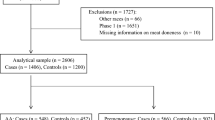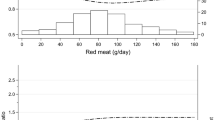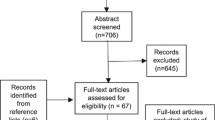Abstract
The association between cured and broiled meat consumption by the mother during pregnancy and by the child was examined in relation to childhood cancer. Five meat groups (ham, bacon, or sausage; hot dogs; hamburgers; bologna, pastrami, corned beef, salami, or lunch meat; charcoal broiled foods) were assessed. Exposures among 234 cancer cases (including 56 acute lymphocytic leukemia [ALL], 45 brain tumor) and 206 controls selected by random-digit dialing in the Denver, Colorado (United States) standard metropolitan statistical area were compared, with adjustment for confounders. Maternal hot-dog consumption of one or more times per week was associated with childhood brain tumors (odds ratio [OR]=2.3, 95 percent confidence interval [CI]=1.0–5.4). Among children, eating hamburgers one or more times per week was associated with risk of ALL (OR=2.0, CI=0.9–4.6) and eating hot dogs one or more times per week was associated with brain tumors (OR=2.1, CI=0.7–6.1). Among children, the combination of no vitamins and eating meats was associated more strongly with both ALL and brain cancer than either no vitamins or meat consumption alone, producing ORs of two to seven. The results linking hot dogs and brain tumors (replicating an earlier study) and the apparent synergism between no vitamins and meat consumption suggest a possible adverse effect of dietary nitrites and nitrosamines.
Similar content being viewed by others
References
Doll R, Peto R. The causes of cancer: quantitative estimates of avoidable risks of cancer in the United States today.JNCI 1981:66: 1191–308.
Archer MC. Hazards of nitrate, nitrite, and n-nitroso compounds in human nutrition. In: Hathcock JN, ed.Nutritional Toxicology, Volume 1. New York, NY, USA: Academic Press, 1982: 327–81.
Crosby NT. Nitrosamines: A review of their chemistry, biological properties, and occurrence in the environment. In: Rechigl M Jr, ed.Handbook of Naturally Occurring Food Toxicants. Boca Raton, FL, USA. CRC Press, 1983: 131–59.
Magee PN, Barnes JM. The production of malignant primary hepatic tumours in the rat by feeding dimethylnitrosamine.Br J Cancer 1956;10: 114–22.
Committee on Nitrite and Alternative Curing Agents in Foods, Assembly of Life Sciences.The Health Effects of Nitrate, Nitrite, and N-Nitroso Compounds. Washington, DC: National Academy Press, 1981.
Bogovski P, Bogovski S. Animal species in which n-nitroso compounds induced cancer. Special report.Int J Cancer 1981;27: 471–4.
Reed PI. The role of n-nitroso compounds in gastric cancer etiology. In: Joossens JV, Hill MJ, Geboers J eds.Diet and Human Carcinogenesis. Amsterdam, The Netherlands. Elsevier Science Publishers, 1985: 97–107.
Tomatis L, Ponomarkov V, Turusov V. Effects of ethylnitrosourea administration during pregnancy on three subsequent generations of BDVI rats.Int J Cancer 1977;19: 240–8.
Tannenbaum SR, Mergens W. Reaction of nitrite with vitamins C and E.Ann NY Acad Sci 1980;355: 267–77.
Reed PI. The role of nitrosamines in cancer formation.Biblthca Nutr Dieta 1986;37: 130–8.
Committee on Diet, Nutrition, and Cancer, National Research Council. Naturally occurring carcinogens. In:Diet, Nutrition, and Cancer. Washington, DC, USA: National Academy Press, 1982; 19–43.
Fraser P, Chilvers C, Beral V, Hill MJ. Nitrate and human cancer: A review of the evidence.Int J Epidemiol 1980;9: 3–11.
Forman D, Al-Dabbagh S, Doll R. Nitrates, nitrites and gastric cancer in Great Britain.Nature 1985;313: 620–5.
Preston-Martin S, Yu MC, Benton B, Henderson BE. N-nitroso compounds and childhood brain tumors: A case-control study.Cancer Res 1982;42: 5240–5.
Olshan AF, Faustman EM. Nitrosatable drug exposure during pregnancy and adverse pregnancy outcome.Int J Epidemiol 1989;18: 891–9.
Committee on Diet, Nutrition, and Cancer, National Research Council. Mutagens in food. In:Diet, Nutrition, and Cancer: Washington, DC, USA: National Academy Press, 1982; 1–27.
Larsson B. Formation of polycyclic aromatic hydrocarbons during the smoking and grilling of food. In: Knudsen I, ed.Genetic Toxicology of the Diet. New York, NY, USA: Alan R. Liss, 1986: 169–80.
Furihata C, Matsushima T. Mutagens and carcinogens in foods.Ann Rev Nutr 1986;6: 67–94.
Lyons JL, Mahoney AW. Fried foods and the risk of colon cancer.Am J Epidemiol 1988128: 1000–6.
Greenberg RS, Schuster Jr JL. Epidemiology of cancer in children.Epidemiol Rev 1985;7: 22–48.
Savitz DA, Wachtel H, Barnes FA, John EM, Tvrdik J. Case-control study of childhood cancer and exposure to 60-Hz magnetic fields.Am J Epidemiol 1988;128: 21–38.
Savitz DA, Zuckerman DL. Childhood cancer in the Denver metropolitan area 1976–1983.Cancer 1987;59: 1539–42.
Brookmeyer R, Liang KY, Linet M. Matched case-control designs and overmatched analyses.Am J Epidemiol 1986;124: 693–701.
Rothman KJ.Epidemiology. Boston, MA, USA: Little, Brown, 1986.
Bunin GR, Kuitjen RR, Boesel CP, Buckley JD, Meadows AT. Maternal diet and risk of astrocytic glioma in children: a report from the Childrens Cancer Group (United States and Canada).Cancer Causes Control 1994;5: 177–87.
Peters JM, Preston-Martin S, London SJ, Bowman JD, Buckley JD, Thomas DC. Processed meats and risk of childhood leukemia in Los Angeles County, California (United States).Cancer Causes Control 1994;5: 195–202.
Bunin GR, Kuitjen RR, Buckley JD, Rorke LB, Meadows AT. Relation between maternal diet and subsequent primitive neutroectodermal brain tumors in young children.N Engl J Med 1993;329: 536–41.
Howe GR, Burch JD, Chiarelli AM, Risch HA, Choi BCK. An exploratory case-control study of brain tumors in children.Cancer Res 1989;49: 4349–52.
Grufferman S, Wang HH, DeLong ER, Kimm SYS, Delzell ES, Falletta JM. Environmental factors in the etiology of rhabdomyosarcoma in childhood.JNCI 1982;68: 107–13.
Willett W.Nutritional Epidemiology. New York, NY, USA: Oxford University Press, 1990.
Author information
Authors and Affiliations
Rights and permissions
About this article
Cite this article
Sarasua, S., Savitz, D.A. Cured and broiled meat consumption in relation to childhood cancer: Denver, Colorado (United States). Cancer Causes Control 5, 141–148 (1994). https://doi.org/10.1007/BF01830260
Received:
Accepted:
Issue Date:
DOI: https://doi.org/10.1007/BF01830260




